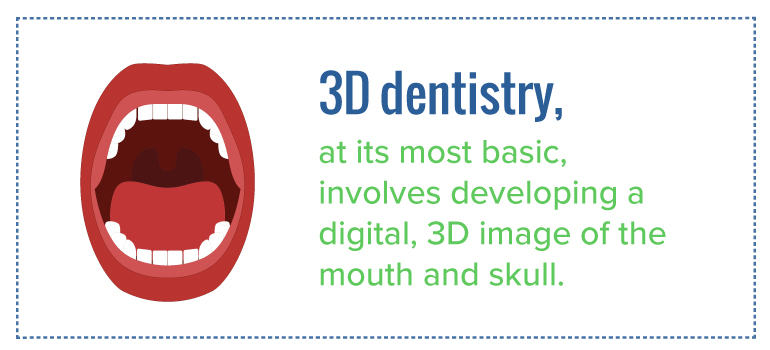
When we think about visiting the dentist’s office, we often think of bright lights, blue bibs, toothbrushes, picks, drills and bubblegum toothpaste. However, advanced imaging utilizing CBCT technology is slowly but surely making its way into dental offices across the United States. Because of their wide recognition as contributors to quality dental care, CBCT machines are now becoming more commonplace among technologically up-to-date offices across the world.
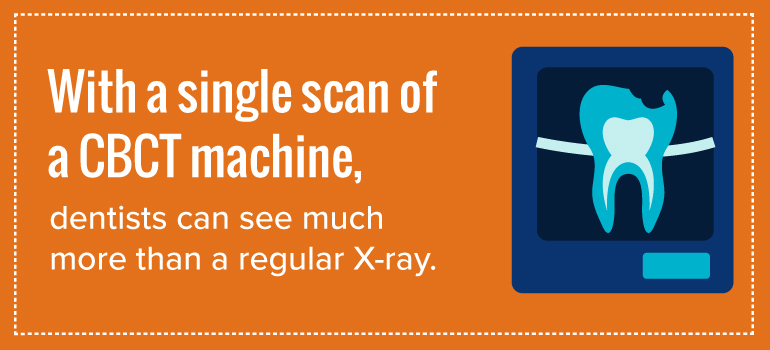
3D dentistry, at its most basic, involves developing a digital, 3D image of the mouth and skull. Traditional X-rays only develop a 2D picture of your mouth, while other methods took longer bouts of radiation to create a detailed picture, and were more unpleasant and intrusive to the patient.
3D dental images are most often used for diagnosis and treatment planning. Being able to see the mouth in three dimensions allows the dentist to better and more effectively formulate an approach to treat dental conditions.

What are the advantages of 3D Dentistry?
Some of the patient benefits of 3D dentistry include the following:
Diagnostic Accuracy: Three-dimensional scans can catch problems 2D scans simply can’t by differentiating between many types of tissue. Pathology, infections, and abnormal sinus anatomy and joint dysfunctions can all be properly visualized and identified with 3D CBCT imaging. This means patients are properly diagnosed the first time and can get appropriate help much sooner than they would with previous methods.
Minimal Radiation Exposure: Repeated prolonged exposure to radiation can cause eye damage, the development of malignancies and other health risks, which is why new medical technologies seek to reduce patient exposure. When compared to traditional medical CT scans, 3D CBCT scans emit substantially less radiation,
reducing the dosage up to 98.5%.
Non-Intrusive: No need to bite down on a mold or piece of plastic. The CBCT can scan your entire head without you needing to do anything. This is especially helpful for patients with particularly sensitive gums or teeth, as well as pediatric patients.
Lower Cost: Going to a third-party imaging center for a medical CT scan can be extremely expensive. Bringing in a 3D CBCT dental imaging device provides all the technology into one place, eliminating the middle-man and saving you money.
Short Scan Time: A typical 3D CBCT scan takes around ten seconds to complete, meaning your dentist can see and solve problems more quickly than ever. An in-house 3D CBCT scanner at your dentists’ office also means you don’t need to go to a third-party imaging company for a medical CT scan.
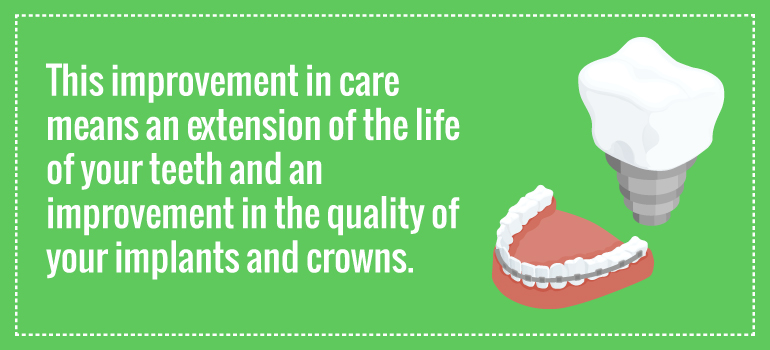 SaveSave
SaveSave
SaveSave
SaveSave
 As the holiday season begins, we ask that you help us feed the hungry. For the seventh year in a row, we are teaming to support The Second Harvest Food Bank of Middle Tennessee and help fight hunger. Just bring in 35 non-perishable food items during the entire month of November and we will schedule your appointment to have your custom fit trays fabricated. If you already have the trays, bring in 20 items and we will restock your bleach.
To provide optimal bleaching results and ensure that prescription bleaching methods are a safe and effective option for you, an exam and recent cleaning are required. Give us a call at 615-254-1393 for further details.
As the holiday season begins, we ask that you help us feed the hungry. For the seventh year in a row, we are teaming to support The Second Harvest Food Bank of Middle Tennessee and help fight hunger. Just bring in 35 non-perishable food items during the entire month of November and we will schedule your appointment to have your custom fit trays fabricated. If you already have the trays, bring in 20 items and we will restock your bleach.
To provide optimal bleaching results and ensure that prescription bleaching methods are a safe and effective option for you, an exam and recent cleaning are required. Give us a call at 615-254-1393 for further details.
 As the holiday season begins, we ask that you help us feed the hungry. For the seventh year in a row, we are teaming to support The Second Harvest Food Bank of Middle Tennessee and help fight hunger. Just bring in 35 non-perishable food items during the entire month of November and we will schedule your appointment to have your custom fit trays fabricated. If you already have the trays, bring in 20 items and we will restock your bleach.
To provide optimal bleaching results and ensure that prescription bleaching methods are a safe and effective option for you, an exam and recent cleaning are required. Give us a call at 615-254-1393 for further details.
As the holiday season begins, we ask that you help us feed the hungry. For the seventh year in a row, we are teaming to support The Second Harvest Food Bank of Middle Tennessee and help fight hunger. Just bring in 35 non-perishable food items during the entire month of November and we will schedule your appointment to have your custom fit trays fabricated. If you already have the trays, bring in 20 items and we will restock your bleach.
To provide optimal bleaching results and ensure that prescription bleaching methods are a safe and effective option for you, an exam and recent cleaning are required. Give us a call at 615-254-1393 for further details.

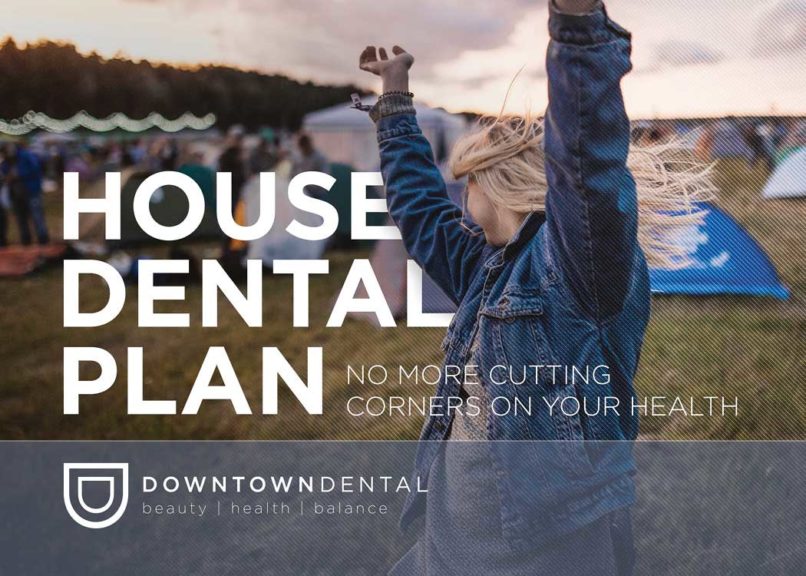 We understand that dental care needs to be affordable, especially for families. We also know that many companies have cut back on dental benefits or even cut them out entirely. Even if you have dental insurance, you may be concerned about your out-of-pocket expenses, so we make every effort to lighten your financial burden.
We understand that dental care needs to be affordable, especially for families. We also know that many companies have cut back on dental benefits or even cut them out entirely. Even if you have dental insurance, you may be concerned about your out-of-pocket expenses, so we make every effort to lighten your financial burden.
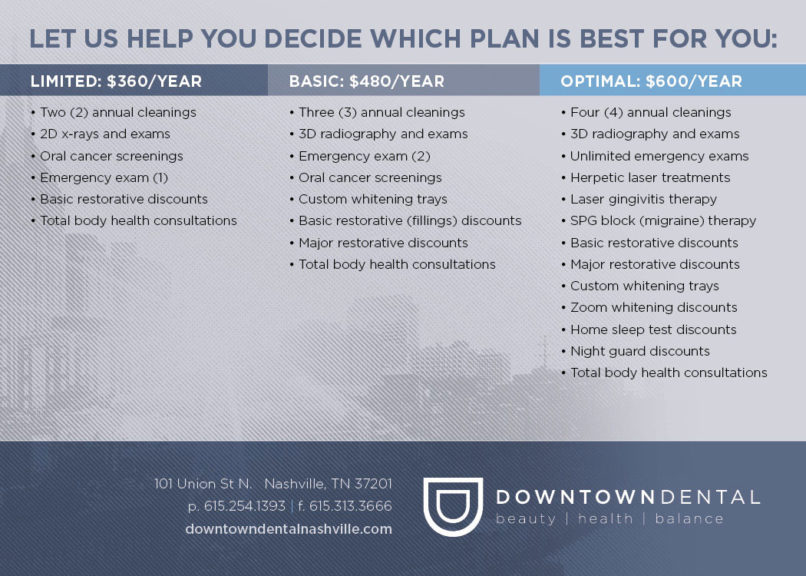
 Teeth whitening can help brighten up a dingy smile. There are many possible choices, from professional whitening in a dentist's office to do-it-yourself kits. Whatever you choose, it's important to get the facts ahead of time. Not everything you hear about teeth whitening is true. Check out these debunked myths.
Myth #1: It's too expensive.
The truth is teeth whitening doesn't have to cost a fortune. At-home tooth whitening is usually more affordable than the professional whitening your dentist does. But that doesn't mean all professional whitening will be out of your budget. Teeth-whitening kits run about $100. In-office professional whitening costs an average of $650. Costs vary widely, though. Some versions can cost as much as $3,500. Your dentist can set you up with at-home whitening trays for about $350.
Myth #2: It will make my teeth too sensitive.
Teeth-whitening solutions in teeth-whitening kits sometimes do make teeth more sensitive, but it’s not a permanent side effect. The bleaching solution may cause mild irritation to your gums as well. That's also temporary. And, there are ways to deal with this so you can still whiten your teeth. Wear the teeth-whitening trays or strips for a shorter amount of time. If you're supposed to apply the solution for an hour, do it in two 30-minute sessions. Take a break for a few days after you first start whitening your teeth. Also, use a toothpaste for sensitive teeth.
Myth #3: It can work for anyone.
Teeth-whitening solutions cannot always get teeth bright white—even if you opt for the pricey in-office whitening treatments. Whitening treatments don't work on dentures, veneers, caps, crowns or fillings. Teeth stained gray or blue, often from medications or trauma, might not whiten. Teeth stained brown might not whiten completely. But, teeth that are yellowish in color usually whiten the best. Talk to your dentist about whether your teeth are likely to respond well to whitening.
Myth #4: I just need to do it once.
Most teeth-whitening treatments need touch-ups. Professional treatments done in a dentist's office may last up to three years. Even then, you may need additional treatments after six months to a year. At-home whitening kits may need more frequent applications. It all depends on your teeth, the whitening solution you use, and your habits. Smoking and drinking coffee can make teeth discolor more quickly, for instance.
Myth #5: You must have the treatment in a dentist's office to get good results.
Not necessarily. Dentists use a concentrated bleaching gel and a light to help whiten teeth. They make sure the amount used is safe and apply something to protect your gums. And, even if you need to repeat the procedure, just one visit can provide results. The American Dental Association has not approved at-home bleaching strips, gel kits, and whitening toothpastes. They may be effective, but it's important to consult your dentist before trying any of them. Ask if a specific teeth-whitening kit would be safe for you. Get some tips to make sure you'll use it correctly.
Learn more about
Teeth whitening can help brighten up a dingy smile. There are many possible choices, from professional whitening in a dentist's office to do-it-yourself kits. Whatever you choose, it's important to get the facts ahead of time. Not everything you hear about teeth whitening is true. Check out these debunked myths.
Myth #1: It's too expensive.
The truth is teeth whitening doesn't have to cost a fortune. At-home tooth whitening is usually more affordable than the professional whitening your dentist does. But that doesn't mean all professional whitening will be out of your budget. Teeth-whitening kits run about $100. In-office professional whitening costs an average of $650. Costs vary widely, though. Some versions can cost as much as $3,500. Your dentist can set you up with at-home whitening trays for about $350.
Myth #2: It will make my teeth too sensitive.
Teeth-whitening solutions in teeth-whitening kits sometimes do make teeth more sensitive, but it’s not a permanent side effect. The bleaching solution may cause mild irritation to your gums as well. That's also temporary. And, there are ways to deal with this so you can still whiten your teeth. Wear the teeth-whitening trays or strips for a shorter amount of time. If you're supposed to apply the solution for an hour, do it in two 30-minute sessions. Take a break for a few days after you first start whitening your teeth. Also, use a toothpaste for sensitive teeth.
Myth #3: It can work for anyone.
Teeth-whitening solutions cannot always get teeth bright white—even if you opt for the pricey in-office whitening treatments. Whitening treatments don't work on dentures, veneers, caps, crowns or fillings. Teeth stained gray or blue, often from medications or trauma, might not whiten. Teeth stained brown might not whiten completely. But, teeth that are yellowish in color usually whiten the best. Talk to your dentist about whether your teeth are likely to respond well to whitening.
Myth #4: I just need to do it once.
Most teeth-whitening treatments need touch-ups. Professional treatments done in a dentist's office may last up to three years. Even then, you may need additional treatments after six months to a year. At-home whitening kits may need more frequent applications. It all depends on your teeth, the whitening solution you use, and your habits. Smoking and drinking coffee can make teeth discolor more quickly, for instance.
Myth #5: You must have the treatment in a dentist's office to get good results.
Not necessarily. Dentists use a concentrated bleaching gel and a light to help whiten teeth. They make sure the amount used is safe and apply something to protect your gums. And, even if you need to repeat the procedure, just one visit can provide results. The American Dental Association has not approved at-home bleaching strips, gel kits, and whitening toothpastes. They may be effective, but it's important to consult your dentist before trying any of them. Ask if a specific teeth-whitening kit would be safe for you. Get some tips to make sure you'll use it correctly.
Learn more about  Over-the-counter pain pills are safer and more effective than prescription opioids for controlling the pain following dental procedures, a review of the evidence has found.
Over-the-counter pain pills are safer and more effective than prescription opioids for controlling the pain following dental procedures, a review of the evidence has found.

 When we think about visiting the dentist’s office, we often think of bright lights, blue bibs, toothbrushes, picks, drills and bubblegum toothpaste. However, advanced imaging utilizing CBCT technology is slowly but surely making its way into dental offices across the United States. Because of their wide recognition as contributors to quality dental care, CBCT machines are now becoming more commonplace among technologically up-to-date offices across the world.
When we think about visiting the dentist’s office, we often think of bright lights, blue bibs, toothbrushes, picks, drills and bubblegum toothpaste. However, advanced imaging utilizing CBCT technology is slowly but surely making its way into dental offices across the United States. Because of their wide recognition as contributors to quality dental care, CBCT machines are now becoming more commonplace among technologically up-to-date offices across the world.
 3D dentistry, at its most basic, involves developing a digital, 3D image of the mouth and skull. Traditional X-rays only develop a 2D picture of your mouth, while other methods took longer bouts of radiation to create a detailed picture, and were more unpleasant and intrusive to the patient.
3D dental images are most often used for diagnosis and treatment planning. Being able to see the mouth in three dimensions allows the dentist to better and more effectively formulate an approach to treat dental conditions.
3D dentistry, at its most basic, involves developing a digital, 3D image of the mouth and skull. Traditional X-rays only develop a 2D picture of your mouth, while other methods took longer bouts of radiation to create a detailed picture, and were more unpleasant and intrusive to the patient.
3D dental images are most often used for diagnosis and treatment planning. Being able to see the mouth in three dimensions allows the dentist to better and more effectively formulate an approach to treat dental conditions.



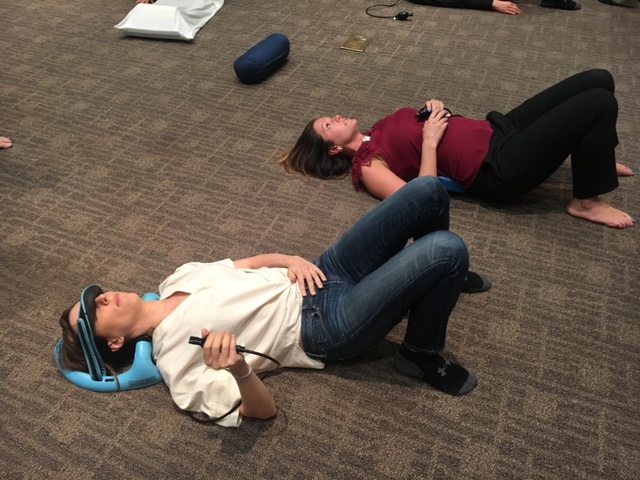 DD Team Members experience the advanced TMJD course with an emphasis in posture, dental orthopedics and upper cervical health in relation the the TMJ.[/caption]
DD Team Members experience the advanced TMJD course with an emphasis in posture, dental orthopedics and upper cervical health in relation the the TMJ.[/caption]

 Whether it's echinacea or aspirin, always tell your dentist about any medications and supplements you are taking.
Everything you ingest, even vitamins, causes a certain reaction. If your dentist doesn’t know what drugs or supplements you have taken, he or she will not know how to protect you from possible substance interactions. This is particularly important if you are undergoing any surgical treatment.
Conventional versus herbal
Although many conventional (prescription and over-the-counter) medications sold in the United States are derived from plants, they are different from herbal medications. Conventional drugs, which must be approved for use by the Food and Drug Administration, are based on an active ingredient or chemical that manufacturers synthesize when they develop the drug. In other words, a conventional drug is based on a chemical that is made in a laboratory, even though it may have originally come from a plant.
Herbal (also called botanical or alternative) medications are made from natural chemicals extracted from a plant and are produced either in original form (sometimes combined with other herbal extracts) or refined. When an herbal medication is refined, the essential extract is taken out of the plant source, concentrated and then added back to make the original herbal medication more potent.
Combinations to avoid
Even seemingly innocuous herbal and vitamin supplements can have serious side effects for a few dental patients. Here are some combinations to be aware of:
Ginkgo biloba and vitamin E can be dangerous when taken with aspirin because they each can act as blood thinners. The combination may cause difficulties in blood clotting, which could be serious for patients undergoing surgery.
Taking high dosages of vitamins before undergoing anesthesia can also cause concern. In particular, vitamin C, often taken in high dosages for cancer treatment, can weaken the efficiency of anesthesia, among other problems.
Calming supplements, such as Kava Kava or St. John's Wort, can strengthen the effects of anesthesia.
What your dentist can do
Always provide your dentist with a complete medical history, including any herbal medication and conventional drugs you are taking.
Some patients who take alternative medicines are afraid the dentist will not respect their decision to take an herbal medication and will tell them to stop taking it; however, as herbal medications become more popular, many dentists are beginning to use them in their practices. Your dentist might even have an alternative, herbal solution for you.
If an herbal medication could interfere with your dental treatment, your dentist may ask you to stop taking the medication until the treatment is complete. The dentist also may be able to prescribe a different drug for treatment, if one is available.
More:
Whether it's echinacea or aspirin, always tell your dentist about any medications and supplements you are taking.
Everything you ingest, even vitamins, causes a certain reaction. If your dentist doesn’t know what drugs or supplements you have taken, he or she will not know how to protect you from possible substance interactions. This is particularly important if you are undergoing any surgical treatment.
Conventional versus herbal
Although many conventional (prescription and over-the-counter) medications sold in the United States are derived from plants, they are different from herbal medications. Conventional drugs, which must be approved for use by the Food and Drug Administration, are based on an active ingredient or chemical that manufacturers synthesize when they develop the drug. In other words, a conventional drug is based on a chemical that is made in a laboratory, even though it may have originally come from a plant.
Herbal (also called botanical or alternative) medications are made from natural chemicals extracted from a plant and are produced either in original form (sometimes combined with other herbal extracts) or refined. When an herbal medication is refined, the essential extract is taken out of the plant source, concentrated and then added back to make the original herbal medication more potent.
Combinations to avoid
Even seemingly innocuous herbal and vitamin supplements can have serious side effects for a few dental patients. Here are some combinations to be aware of:
Ginkgo biloba and vitamin E can be dangerous when taken with aspirin because they each can act as blood thinners. The combination may cause difficulties in blood clotting, which could be serious for patients undergoing surgery.
Taking high dosages of vitamins before undergoing anesthesia can also cause concern. In particular, vitamin C, often taken in high dosages for cancer treatment, can weaken the efficiency of anesthesia, among other problems.
Calming supplements, such as Kava Kava or St. John's Wort, can strengthen the effects of anesthesia.
What your dentist can do
Always provide your dentist with a complete medical history, including any herbal medication and conventional drugs you are taking.
Some patients who take alternative medicines are afraid the dentist will not respect their decision to take an herbal medication and will tell them to stop taking it; however, as herbal medications become more popular, many dentists are beginning to use them in their practices. Your dentist might even have an alternative, herbal solution for you.
If an herbal medication could interfere with your dental treatment, your dentist may ask you to stop taking the medication until the treatment is complete. The dentist also may be able to prescribe a different drug for treatment, if one is available.
More: